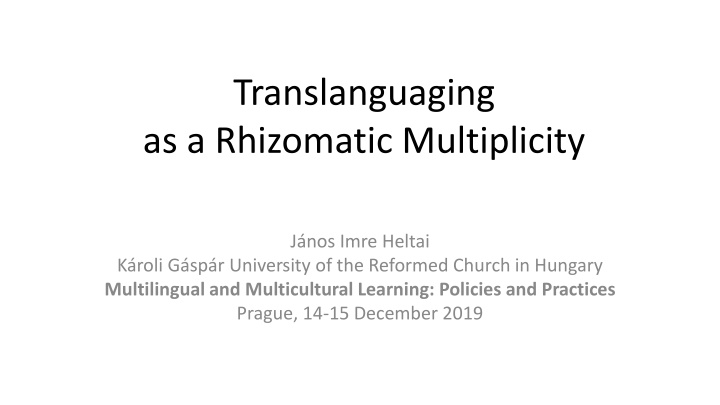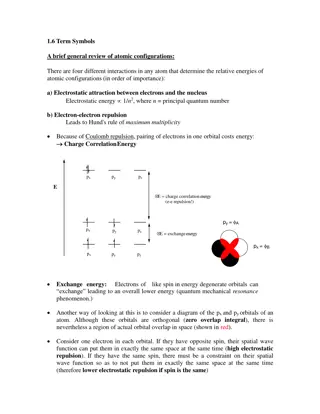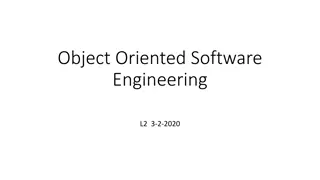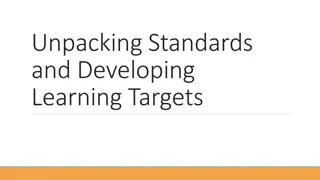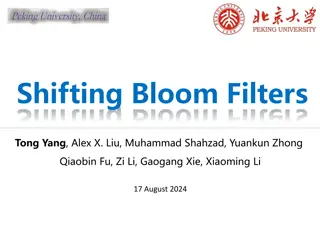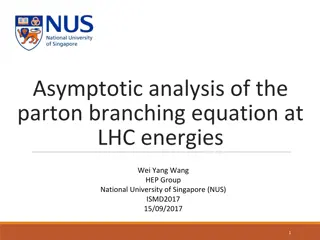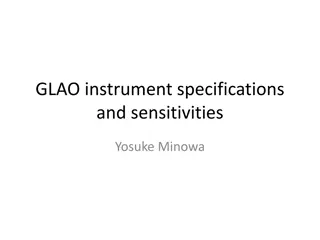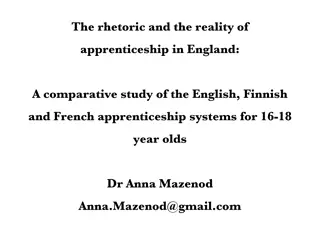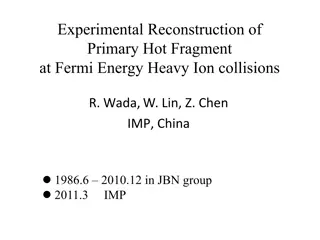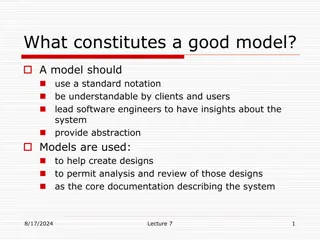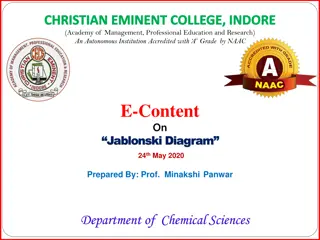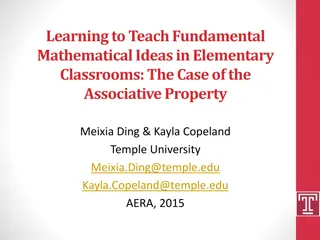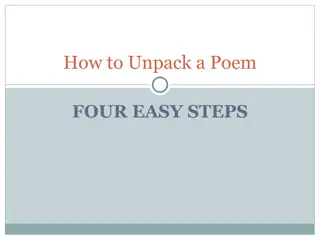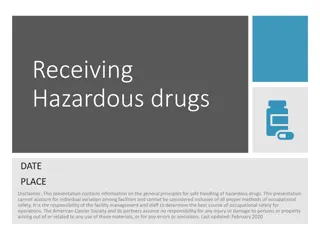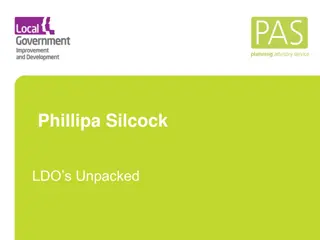Unpacking Translanguaging as a Rhizomatic Multiplicity
Explore the rhizomatic nature of Translanguaging, its criticisms, and the concept of multiplicity within linguistic repertoires. Understand how rhizomes function in sociolinguistic research and their implications for language issues and cognition. Delve into the complexities of translanguaging and its transformative potential in education policies.
Download Presentation

Please find below an Image/Link to download the presentation.
The content on the website is provided AS IS for your information and personal use only. It may not be sold, licensed, or shared on other websites without obtaining consent from the author.If you encounter any issues during the download, it is possible that the publisher has removed the file from their server.
You are allowed to download the files provided on this website for personal or commercial use, subject to the condition that they are used lawfully. All files are the property of their respective owners.
The content on the website is provided AS IS for your information and personal use only. It may not be sold, licensed, or shared on other websites without obtaining consent from the author.
E N D
Presentation Transcript
Translanguaging as a Rhizomatic Multiplicity J nos Imre Heltai K roli G sp r University of the Reformed Church in Hungary Multilingual and Multicultural Learning: Policies and Practices Prague, 14-15 December 2019
Outline I argue that the main reason for both the rapid spread of the term Translanguaging (TL) and for its many-sided criticism is that it has a rhizomatic characteristic. Employing Deleuze and Guattaris rhizome-metaphor (1987) helps us to Understand better the versatility of the emerging concept Counter criticisms regarding the insufficiency and inconsistency of the term My contribution to these discussions is based on three years of experience obtained through joint work with teachers in a project inspired by translanguaging theory.
The critiques of TL Criticisms and doubts concerning TL as a theoretical framework The theoretical adequacy of the concept of unitary linguistic repertoires (MacSwan 2017) The appropriateness of the term translanguaging to describe all or many of the kinds of multilingual practices (Auer 2019) (In the context of educational issues concerns emerge regarding the transformative power of the concept to fight inequality (Jaspers 2018) or its omnipotence to change education policies (Jaspers 2019). Further criticisms concern the controversial effects and consequences of translanguaging for regional minority language policies [Cenoz and Gorter 2017, 2019])
Rhizome These systems do not have an isolated and unequivocal pivot, but they comprise distinct nodes and intersections, all bound to each other in varied ways. Often referred in sociolinguistic research (Pietik inen 2015, Milani and Levon 2016, Lepp nen and Kyt l 2017, Canagarajah 2018, Heller, Pietik inen and Pujolar 2018, Prinsloo Krause 2019)
A metaphor for the overall operation of human cognition and thinking, including language issues Connection and heterogeneity, according to which any point of the rhizome can be connected to anything other, and must be Multiplicity: rhizomes have determinations, magnitudes, dimensions that cannot increase in number without the multiplicity changing in nature . Rhizomes multiplicities are defined by outside factors, the line of flight or deterritorialization, according to which they change in nature and connect with other multiplicities Asignifying rupture, which means that every rhizome contains lines of segmentarity Cartography and decalcomania: a rhizome is like a map because it is entirely oriented toward an experimentation in contact with the real , and is open and connectable in all of its dimensions; it is detachable, reversible, suspectible to constant modification (Deleuze and Guattari 1987: 7-12)
The translanguaging-rhizome: multiplicities changing in nature 1 TL as a label for linguistic practices Is blurring the units of named languages (considered to be social inventions) Is based on the assumption of an undifferentiated cognitive terrain not fenced off into areas of named languages (Otheguy, Garc a and Reid 2018: 2 3) Is multimodal in at least two ways It comprises multimodal signs including bodies, gestures, lives etc. (Garc a and Otheguy 2019: 8) It transcends the traditional divides between linguistic and non-linguistic cognitive and semiotic systems (Li 2018: 20). TL as an educational orientation TL as a theoretical approach
The translanguaging-rhizome: multiplicities changing in nature 2 TL as an educational orientation: Efforts to identify new (school) language policy solutions (Cenoz and Gorter 2017, Prinsloo and Krause 2019) Efforts with strong political and social commitment (Garc a and Kleyn 2016: 24 25) TL as a theoretical approach TL is the theory that describes the operation of language as a multisensory and multimodal semiotic system interconnected with other identifiable but inseparable cognitive systems (Li 2018: 20) The connection between different systems and resources is also central in other approaches positioning translanguaging as a framework (Garc a and Otheguy 2019; Pennycook 2017)
Criticisms of translanguaging MacSwan states that the concept of the unitary linguistic repertoire weakens the conceptual framework of sociolinguistics, which contains treasured icons like language rights, mother tongues or codeswitching (2017: 169). While considering speech communities, MacSwan argues that to dispense with these categories would make sociolinguistics wholly incongruous (2017: 177). Auer claims that TL is a step backward from codeswitching theories. It covers too many of the phenomena formerly subsumed under the heading of language contact and bilingual practices, and leads to a less fine-grained description of human communication (2019: 16) Criticisms of this kind signal the non-recognition or unacceptance of the rhizomatic features of TL. In both cases, the argumentation is based on the assumption that the repertoire is dichotomously structured and consists of distinguishable entities.
The root-tree and the rhizome Deleuze and Guattari: This assumption is based on the image of the root-tree, endlessly developing the law of the One which becomes two, then of the two that becomes four (1987: 5). The root-tree is even in linguistics a fundamental image (as shown by Chomsky s phrase- structure grammar), but this concept has never reached an understanding of multiplicity (ibid.) What they promote instead of the image of the root-tree is anexactitude (this aspect is heavily criticised by codeswitching scholars: cf. TL is loosing sight ) Anexactitude is in no way an approximation; on the contrary, it is the exact passage of that which is under way. We invoke one dualism only in order to challenge another. We employ a dualism of models only in order to arrive at a process that challenges all models. Each time, mental correctives are necessary to undo the dualisms we had no wish to construct but through which we pass. Arrive at the magic formula we all seek PLURALISM=MONISM (Deleuze and Guattari 1987: 20, capitalizing in the original).
A translanguaging project within the framework of monolingual educational policies A school in a small town in Eastern Hungary. The students belong to the Roma minority and form a community, which is regarded as a bilingual one. The teachers at this school regard themselves as non-Roma monolingual Hungarians Teachers participating in the project encourage students to take advantage of their translingual home language practices in their school activities and they themselves also initiate translanguaging exercises. Methodology linguistic ethnographic fieldwork since 2016 (26 hours of recordings) experimental lessons and workshops were continued, some teachers began to develop a translanguaging stance. (60 lessons, 15 workshops) Currently, successful translanguaging theatre or movie projects and everyday classroom work are constantly challenging old monolingual practices.
The image of the root-tree Hungarian language vs. Romani-Hungarian mixed code Romani Resources vs. Hungarian resources as part of the mixed code cases of alternational mixing vs insertational mixing F: S: F: S: szo keresz, Andr s, teh r ? ( What are you doing, Andr s, tomorrow? ) teh r ? ( Tomorrow ) igen, k j? ( Yes. Where? ) Gyav po meccso, t j gy v k ring i tanoda n gykor. De n j biztos, hogy gyav. ( I go to the football match, and go to the summer school at four. But I m not sure, if I go ) Kahal focizinen teh r ? ( with whom are you playing tomorrow? ) Grund FC pesteke cs p tov kel sz. ( we play with Grund FC, a team from Budapest ) ujuj ( uh oh ) L cso felk sz l si vl amenge. ( It will be a good preparation for us ) bajnoks go k n k vl tume? ( When starts the championship for you? ) majd huszonegyedik n kezd dinel. Elvileg. ( It begins at the 21th. In theory. ) kh re futbalozinen? ( Are you playing at home? ) , akanak gyasz po [X = a neighboored village]. othe kezdinasz az els meccset, [X]. ( No, now we go to X. We start the first play there, X. ). F: S: F: S: F: S: F: S:
Problematic points of the root-tree logic The classic dilemma of loanwords vs. codeswitching, i. e. that the differentiation between alternational mixing and switching to the Hungarian monolingual code cannot be exact There are different possibilities to assign these ways of speaking to one or the other language: resources in this conversation (for example, the resource cs p tov ) are assigned differently From a scholarly perspective: a loanword (Hungarian csapat team ) with insertional mixing (it has a Romani affix) In the assessment of Hungarian monolingual teachers at the school, a borrowed Hungarian word However, when translanguaging, it is pronounced by the students differently from its Hungarian pronunciation (with two [a]-s instead of [ ]-s in the root). This may be one of the reasons why Roma speakers, especially youngsters and children tend to regard it as a Romani word.
Open and connectable in all of its dimensions (Deleuzeand Guattari 1987: 12) Translanguaging scholars follow a rhizomatic logic Translanguaging is not about losing sight of diverse bilingual practices. On the contrary, due to its rhizomatic features, it is suitable for involving new, speaker-related dimensions in the description of bi- and multilingual ways of speaking and to offer more fine grained understanding of multilingual practices. In this specific case, in the locality under study, the concept of translanguaging is not only helpful in deciding how speakers select and deploy codes linked to Hungarian and to a Hungarian-Romani mixed code. Additionally, due to its speaker-centred character, it may also provide assistance in exploring and registering speakers perceptions of the resources they use.
Thank you for your attention! heltai.janos@kre.hu . Auer, Peter. 2019. Translanguaging or Doing Languages ? Multilingual Practices and the Notion of Codes . Available at researchgate.net, Author s copy, pre- reviewing version. 1-31. Written for: Language(s): Multilingualism and Its Consequences, edited by J. MacSwann. Clevedon: Multilingual Matters. Series Language, Education and Diversity Canagarajah, Suresh. 2018. Translingual Practice as Spatial Repertoires: Expanding the Paradigm beyond Structuralist Orientations. Applied Linguistics 39(1). 31 54. Cenoz, Jasone, and Durk Gorter. 2017. Minority languages and sustainable translanguaging: threat or opportunity? Journal of Multilingual and Multicultural Development 38(10). 901 912. Cenoz, Jasone, and Durk Gorter. 2019. Multilingualism, Translanguaging, and Minority Languages in SLA. The Modern Language Journal 103(S1). 130 135. Deleuze, Gilles, and Felix Guattari. 1987. A Thousand Plateaus. (Introduction: Rhizome). Minneapolis: University of Minnesota Press. Garc a, Ofelia, and Ricardo Otheguy. 2019. Plurilingualism and Translanguaging: Commonalities and Divergences. International Journal of Bilingual Education and Bilingualism. Garc a, Ofelia, and Tatyana Kleyn. 2016. Translanguaging with MultilingualStudents: Learning from Classroom Moments. New York: Routledge. Heller, Monica, Sari Pietik inen, and Joan Pujolar. 2018. Critical Sociolinguistic Research Methods: Studying Language Issues That Matter. New York London: Routledge. Jaspers, J rgen. 2018. The transformative Limits of Translanguaging. Language and Communication 58. 1 10. Jaspers, J rgen. 2019. Authority and Morality in Advocating Heteroglossia. Language, Culture and Society 1. 83 105. Lepp nen, Sirpa, and Samu Kyt l . 2017. Investigating Multilingualism and Multisemioticity as Communicative Resources in Social Media. In Researching Multilingualism. Critical and ethnographic perspectives, edited by Marilyn Martin-Jones, Deirdre Martin, 155 171. New York London: Routlegde. Li Wei. 2018. Translanguaging as a practical theory of language. Applied Linguistics 39. 9 30. MacSwan, Jeff. 2017. A Multilingual Perspective on Translanguaging. American Educational Research Journal 54(1). 167 201. Milani, Tommaso M., and Erez Levon. 2016. Sexing Diversity: Linguistic Landscapes of Homonationalism. Language & Communication 51. 69 86. Otheguy, Ricardo, Ofelia Garc a, and Wallis Reid. 2018. A Translanguaging View of the Linguistic System of Bilinguals. Applied Linguistics Review. 1 27. Pennycook, Alastair. 2017. Translanguaging and Semiotic Assemblages. International Journal of Multilingualism 14(3). 269 282. Pietik inen, Sari. 2015. Multilingual Dynamics in S miland: Rhizomatic Discourses on Changing Language. International Journal of Bilingualism 19(2). 206 225. Prinsloo, Mastin, and Lara-Stephanie Krause. 2019. Translanguaging, Place and Complexity. Language and Education 33(2). 159 173.
A translanguaging project as a rhizomatic multiplicity Students bring their translanguaged practices into school, teachers are developing a translanguaging stance. The project is constantly rewriting interpersonal power relations and task fields among the participants. One of the lower grade teachers reported that Utilizing translanguaging educational practices can be contradictory in the case of frontal teaching because students translanguaged practices are only sporadically intelligible to monolingual Hungarian teachers. They consequently lose control and learning processes become more time-consuming. Furthermore, it is confusing for students to engage in translanguaging in the presence of a dominant monolingual teacher. In contrast, with a cooperative learning approach, translanguaging exerts its transformative power in multiple interrelated ways, according to this teacher, without any disadvantages. In this case students will appear as helpers of the teacher. Those who find it hard to understand the tasks because of lacunae in their Hungarian competences, will speak more fluently and feel free to ask for help. There is an increase in the role of constructive interdependence in class. One of the most important characteristics of the rhizome is that it always has multiple entryways (Deleuze and Guattari 1987: 12). For local teachers, learning organisation is the main entryway to the translanguaging rhizome.
